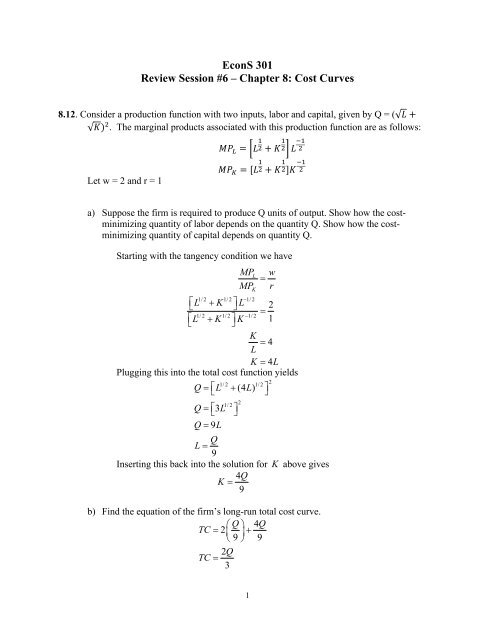EconS 301 Review Session #6 â Chapter 8: Cost Curves
EconS 301 Review Session #6 â Chapter 8: Cost Curves
EconS 301 Review Session #6 â Chapter 8: Cost Curves
You also want an ePaper? Increase the reach of your titles
YUMPU automatically turns print PDFs into web optimized ePapers that Google loves.
<strong>EconS</strong> <strong>301</strong><strong>Review</strong> <strong>Session</strong> <strong>#6</strong> – <strong>Chapter</strong> 8: <strong>Cost</strong> <strong>Curves</strong>8.12. Consider a production function with two inputs, labor and capital, given by Q = (√ √ . The marginal products associated with this production function are as follows: Let w = 2 and r = 1a) Suppose the firm is required to produce Q units of output. Show how the costminimizingquantity of labor depends on the quantity Q. Show how the costminimizingquantity of capital depends on quantity Q.Starting with the tangency condition we haveMPLw=MPKr1/2 1/2 −1/2⎣⎡L + K ⎤⎦L2=1/2 1/2 −1/2⎡⎣L + K ⎤⎦K1K= 4LK = 4LPlugging this into the total cost function yieldsQ = ⎡⎣L + (4 L)Q1/2 1/21/22= ⎡ ⎣ 3L⎤ ⎦Q = 9LQL =9Inserting this back into the solution for K above gives4QK =9b) Find the equation of the firm’s long-run total cost curve.⎛Q⎞4QTC = 2⎜⎟+⎝ 9 ⎠ 92QTC =3⎤⎦21
c) Find the equation of the firm’s long-run average cost curve.TC ⎛2Q⎞AC = =⎜ ⎟ QQ ⎝ 3 ⎠2AC =3d) Find the solution to the firm’s short-run cost-minimization problem when capital isfixed at a quantity of 9 units (i.e. = 9).When Q ≤ 9 the firm needs no labor. If Q > 9 the firm must hire labor. SettingK = 9 and plugging in for capital in the production function yields1/2 1/22Q = ⎡⎣L+ 9 ⎤⎦1/2 1/2Q = L + 31/2 1/2L = Q −3Thus,L⎡⎣Q1/2= −3⎤⎦1 2⎪⎧ ⎡ Q 2− 3 ⎤ if Q>9L = ⎨ ⎣ ⎦⎪ ⎩0 if Q ≤ 9e) Find the short-run total cost curve, and graph it along with the long-run total costcurve.⎪⎧ 2( Q1/2 − 3) 2+ 9 when Q>9TC = ⎨⎪⎩ 9 when Q ≤ 92Graphically, short-run and long-run total cost are shown in the following figure.Total <strong>Cost</strong>25.0020.0015.0010.005.000.00SRTCLRTC0 5 9 10 15 20 25 30Q2
f) Find the associated short-run average cost curve.⎧2( Q1/2 − 3) 2+ 9⎪ if Q > 9TC ⎪AC =Q=⎨Q ⎪ 9⎪if Q ≤ 9⎩Q8.14. A hat manufacturing firm has the following production function with capital and laborbeing the inputs: Q=min(4L, 7K)―that is it has a fixed-proportions production function.If w is the cost of a unit of labor and r is the cost of a unit of capital, derive the firm’slong-run total cost curve and average cost curve in terms of the input prices and Q.The fixed proportions production function implies that for the firm to be at a costminimizing optimum, 4 L = 7Kand both of these equal Q. Therefore, L = Q/4 andw rK = Q/7. So the firm’s total cost is wL + rK = wQ / 4 + rQ / 7 = [ + ] Q .4 7w rThe average cost curve is LRAC = TC / Q = + . Note that this average cost4 7curve is independent of Q and is simply a straight line.8.19. Consider a production function of three inputs, labor, capital, and materials, given byQ=LKM. The marginal products associated with this production function are as followsLMP L =KM, MP K =LM, and MP M =LK. Let w = 5, r =1, and m = 2, where m is the price perunit of materials.a) Suppose that the firm is required to produce Q units of output. Show how the costminimizingquantity of labor depends on the quantity Q. Show how the cost-minimizingquantity of capital depends on the quantity Q. Show how the cost-minimizing quantity ofmaterials depends on the quantity Q.Equating the bang for the buck between labor and capital impliesMPLw=MPKrKM 5=LM 1K = 5LEquating the bang for the buck between labor and materials implies3
MPMPLMw=mKM 5=KL 25LM =2Plugging these into the production function yields⎛5L⎞Q= L(5 L)⎜ ⎟⎝ 2 ⎠325LQ =23 2QL =251/3⎛2Q⎞L = ⎜ ⎟⎝ 25 ⎠Substituting into the tangency condition results above implies1/3⎛2Q⎞K = 5 ⎜ ⎟⎝ 25 ⎠andM5⎛2Q⎞= ⎜ ⎟2⎝25 ⎠1/3b) Find the equation of the firm’s long-run total cost curve.1/3 1/3 1/3⎛2Q⎞ ⎛2Q⎞ ⎛5⎞⎛2Q⎞TC = 5⎜ ⎟ + 5⎜ ⎟ + 2⎜ ⎟⎜ ⎟⎝ 25 ⎠ ⎝ 25 ⎠ ⎝2 ⎠⎝ 25 ⎠1/3⎛2Q⎞TC = 15⎜ ⎟⎝ 25 ⎠c) Find the equation of the firm’s long-run average cost curve.1/3TC 15 ⎛2Q⎞AC = = ⎜ ⎟Q Q ⎝ 25 ⎠d) Suppose that the firm is required to produce Q units of output, but that its capital isfixed at a quantity of 50 units (i.e. 50). Show how the cost-minimizingquantity of labor depends on the quantity Q. Show how the cost-minimizingquantity of materials depends on the quantity Q.Beginning with the tangency condition4
MPMPLMw=mKM 5=KL 25LM =2Setting K = 50 and substituting into the production function yields⎛5L⎞Q= L(50)⎜ ⎟⎝ 2 ⎠2Q=125LQL =125Substituting this result into the tangency condition result above impliesQ5M = 1252QM =20e) Find the equation of the short-run total cost curve when capital is fixed at a quantity of50 units (i.e. 50) and graph it along with the long-run total cost curve.In the short run,TC = 5Q Q+ 50+2125 20TC = 2Q+ 505Graphically, short-run and long-run total cost curves are shown in the followingfigure.5
Total <strong>Cost</strong>120.00100.0080.0060.0040.0020.000.00SRTCLRTC0 1000 2000 3000 4000 5000Qf) Find the equation of the associated short-run average cost curve.Short run average cost is given byQ2 + 50TCAC = =5Q Q6

















